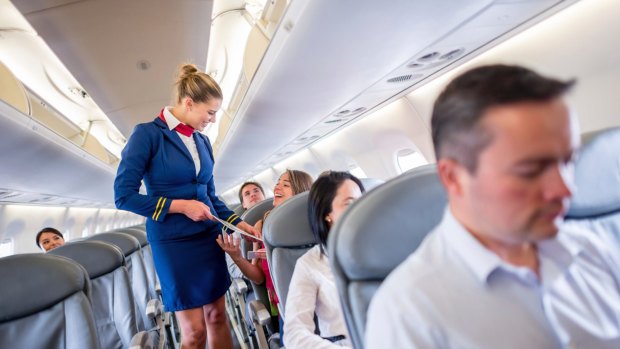This was published 8 years ago
The fastest way to get your airline complaints heard is on Twitter

Got something to say about your flight? The fastest way to an airline's customer service departments is via social media.Credit: iStock
Sid Banerjee and a colleague had been stranded at Chicago's O'Hare International Airport for several hours in April. The tech company chief executive had missed his connecting flight, was resigned to missing his meeting and was just trying to get back to Washington.
"I could not get someone to reroute me back home," Banerjee said. After fruitless hours trying to get assistance over the phone or at the ticket counter, his colleague, who did not want to be identified, turned to Twitter. "We said, 'We should tweet about it,'" Banerjee said.
He had a strong hunch they might get some kind of response. Their company, Clarabridge, sells social media analytics software to travel companies. Twitter, he figured, might give him a digital backdoor.
"Social in particular, because it's not the dominant path for communication between customers and airlines, does tend to have a shorter queue," he said.
It might not be that way for long. The typewritten complaint sent by letter to a company's headquarters is rapidly becoming as outdated as a telegraph message.
Airlines say they are reinforcing their customer service departments with social media specialists to field the thousands of questions, comments and gripes that pour in every week via channels like Facebook, Instagram and especially Twitter.
While hotels have also been expanding their social customer support departments, airlines say Twitter seems ready-made for fielding comments or complaints.
"The channel seems to be set up for that immediate two-way conversation," said Charles Hobart, a United Airlines spokesman. "It gives them a voice and it gives them a format to reach out to us."
Hobart said messages typically pertained to schedule questions or suggestions, baggage and delay or cancellation issues, and compliments about positive travel experiences.
"The expectations of social have absolutely changed the nature of customer support and added a lot of challenge for large brands," said Ryan Holmes, chief executive of Hootsuite, a social media management company. "The old expectation that someone would call a 1800 number and sit on a line and wait doesn't happen anymore. Customers need real-time responses."
While travellers have come to expect a near-instant reply, companies have been trying to meet that expectation.
Brian Kruse, a spokesman for Delta Air Lines, said it had increased its social media team by roughly 30 per cent over the last year. Now, about 40 staff members monitor and respond to the roughly 3000 tweets a day that Delta receives.
"If someone has a question about a delayed flight and they're in the airport, that's something we want to handle right then and there," said Ashley Mainz, the social business manager on the social business team at Southwest Airlines. It has a dedicated team of 29 that fields the roughly 80,000 posts a month that come through Facebook and Twitter, building from a base of just a few employees in a little over a year.
Jonathan Pierce, director of social media for American Airlines, said it has 26 people dedicated to social media customer service.
"You now see folks with Wi-Fi on board - if they need assistance on board, they'll tweet us," he said. "Perhaps if their bag isn't there within five minutes, they'll tweet us. "There's an expectation from the customers that we're there to listen to that and act on it."
Seth Miller, a blogger and travel technology and loyalty program consultant who travels often, said he often used Twitter to communicate with airlines, even from the plane.
"I was on a flight that was delayed, we were in the process of boarding, and I was worried about my next connection," he said. "Even though we expect real-time responses, you don't have to actually be on the phone to get things fixed."
Before the plane door shut, Miller exchanged a few tweets with a customer service representative and provided his information through a direct message. When he landed, he had another message telling him his connecting flight had been secured.
Morgan Johnston, a social media strategist at JetBlue Airways, said it's not just tied to social media but connectivity in general.
"We certainly have seen a shift as more and more customers are connected, and as you see the ubiquity of Wi-Fi at altitude," he said.
These missives aren't completely replacing phone and other online complaints, which travel industry consultants say is a double-edged sword.
"There's a real risk there, especially not only because I have this easy way to complain, but I also have that same platform to tell everybody," Miller said. "That creates this sort of asymmetric expectation that it's hard for the airline to always meet."
The immediacy and the ease of Twitter and its 140-character format make it ideally suited for registering small annoyances that, in a past era, wouldn't have warranted a more formal complaint.
"A customer's probably not going to call and say they're disappointed they didn't have the option of PopCorners on our flight," Johnston said.
This greater volume of complaints means more work, but companies say they welcome the chance to make an even slightly perturbed customer happier.
"By being proactive, it becomes much more immediate," Johnston said. "We've seen a rise in our customer satisfaction because we can get ahead of it before they go home for the day and start stewing about it."
This is part of the trade-off of engaging with customers through Twitter, Banerjee said.
"On a very public channel, if you solve their problems you're likely to get a positive response," he said. "It's not uncommon for the customer to say thank you, and that does help."
The New York Times
Sign up for the Traveller newsletter
The latest travel news, tips and inspiration delivered to your inbox. Sign up now.